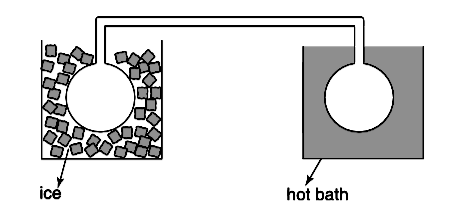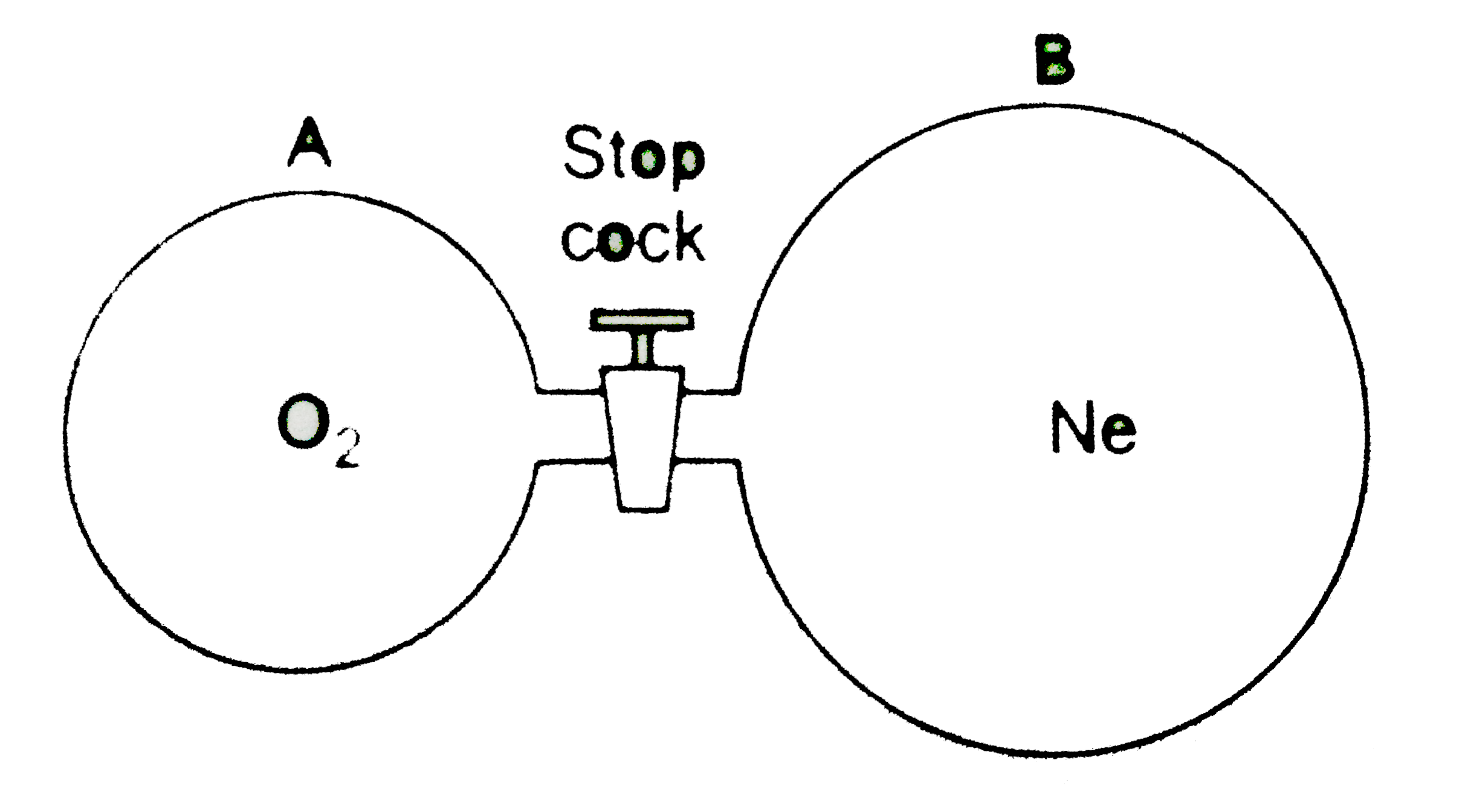Two glass bulbs x and y are connected by a very small tube having a stop - cock. Bulb X has a volume of 100cm3 and contained the gas, while bulb Y was empty. On opening the stop - cock, the pressure fell down to 60%. The volume of the bulb Y must be
132.32cm3
124cm3
66.66cm3
150cm3
The correct Answer is:C
To solve the problem, we will use the ideal gas law and the relationship between pressure and volume. Let's break it down step by step.
Step 1: Understand the Initial Conditions
- Bulb X has a volume VX=100cm3 and contains gas at pressure P.
- Bulb Y is empty initially, so its volume VY is unknown.
Step 2: Analyze the Change in Pressure
- When the stopcock is opened, the pressure in the system drops to 60% of the original pressure P.
- Therefore, the new pressure P′=0.6P.
Step 3: Apply the Ideal Gas Law
Using the ideal gas law, we know that:
P1V1=P2V2
Where:
- P1 is the initial pressure in bulb X,
- V1 is the initial volume of bulb X,
- P2 is the new pressure after opening the stopcock,
- V2 is the total volume of the system after opening the stopcock (which is VX+VY).
Step 4: Set Up the Equation
Substituting the known values into the equation:
P⋅100=0.6P⋅(100+VY)
Step 5: Simplify the Equation
We can cancel P from both sides (assuming P≠0):
100=0.6(100+VY)
Step 6: Distribute and Rearrange
Distributing 0.6:
100=60+0.6VY
Now, subtract 60 from both sides:
40=0.6VY
Step 7: Solve for VY
To find VY, divide both sides by 0.6:
VY=400.6=4006≈66.67cm3
Final Answer
The volume of bulb Y must be approximately 66.67cm3.
---
- Bulb X has a volume VX=100cm3 and contains gas at pressure P.
- Bulb Y is empty initially, so its volume VY is unknown.
- When the stopcock is opened, the pressure in the system drops to 60% of the original pressure P.
- Therefore, the new pressure P′=0.6P.
Using the ideal gas law, we know that:
P1V1=P2V2
Where:
- P1 is the initial pressure in bulb X,
- V1 is the initial volume of bulb X,
- P2 is the new pressure after opening the stopcock,
- V2 is the total volume of the system after opening the stopcock (which is VX+VY).
Substituting the known values into the equation:
P⋅100=0.6P⋅(100+VY)
We can cancel P from both sides (assuming P≠0):
100=0.6(100+VY)
Distributing 0.6:
100=60+0.6VY
40=0.6VY
To find VY, divide both sides by 0.6:
VY=400.6=4006≈66.67cm3
The volume of bulb Y must be approximately 66.67cm3.
Topper's Solved these Questions
Similar Questions
Two glass bulbs of equal volume and filled with an ideal gas at 500 K and pressure of 76 cm of Hg are connected by a norrow tube.One of the bulb is then placed in a water bath maintained at 700 K and the other bulb is maintained at 500 K.What is the new value of the pressure (in cm of Hg) inside the bulbs ? The volume of the connecting tube is negligible.Report your answer after multiplying by 67.
View SolutionTwo identical glass bulbs are interconnected by a thin tube of negligible volume. An ideal gas is filled in the bulbs at STP. One bulb is placed in a tub of melting ice and the other bulb is placed in a hot bath. The gas pressure in the bulbs becomes 1.5 times. Find the tem perature of the hot bath. Which bulb has more gas?

View Solution
Knowledge Check
Two glass bulbs A and B are connected by a very small tube having a stop cock. Bulb A has a volume of 100 cm3 and contained the gas, while bulb B was empty. On opening th stop cock. The pressure fell down to 40%. The volume of the bulb B must be:
A75cm3B125cm3C150cm3D250cm3Two glass bulbs A and B are connected by very small tube having a stop cock. Bulb A has a volume of 100 ml and contained the gas while bulb B was empty and had a volume of 150 ml. on opening the stop-cock, the pressure of the gas in bulb A will fall down to:
A0.8B0.6C0.4D0.2Two glass bulbs A and B are connected by a very small tube having a stop cock. Bulb A has a volume of 100 cm3 and contained the gas, while bulb B was empty. On opening th stop cock. The pressure fell down to 40%. The volume of the bulb B must be:
A200B125C66D75
two glass bulbs of equal volume are connected by a narrow tube and are filled with a gas at 0(∘)C at a pressure of 76cm of mercury. One of the bulbs is then placed in melting ice and the other is placed in a water bath maintained at 62∘C.What is the new value of the pressure inside the bulbs? The volume of the connecting tube is neigligible.
View SolutionTwo glass bulbs of equal volume are connected by a narrow tube and are filled with a gas at 0∘C and a pressure of 76cm of mercury. One of the bulbs is then placed in melting ice and the other is placed in a water bath maintained at 62∘C. What is the new value of the pressure inside the bulbs? The volume of the connecting tube is negligible.
View SolutionInitially bulb "a" contained oxygen gas at 27∘C and 950 mm of Hg and bulb "B" contained neon gas at 27∘C and 900 mm of Hg. These bulbs are connected by a narrow tube of negligible volume equipped with a stopcock and gases were allowed to mix-up freely. The pressure obtained in the combined system was found to be 910 mm of Hg.

If volume of bulb B was measured to be 10 L, then find the volume of oxygen gas present initially in bulb "A" .
View SolutionTwo identical glass bulbs, connected by a thin glass tube, are filled with He gas at S.T.P one of the bulbs is placed in a vessel containign ice while other is placed in a hot bath. The pressure of the gas increases to 1.5 times the initial pressure. If the temperature of a hot bath is 10t∘C. Find the value of t.
View SolutionTwo gases bulbs A and B are connected by a tube having a stopcock. Bulb A has a volume of 100mL and contains H2 gas . After opening the gas from A to the evacuated bulb B , the pressure falls down by 40%. The volume (mL)ofB must be
View Solution
